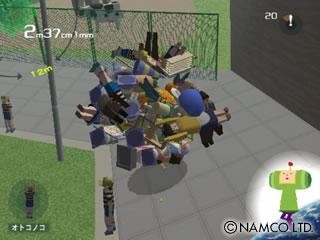Calamari Misterdarcy
Oct 19, 2004 · peterb · 4 minute readGames
What are all the cool kids playing on their consoles today? Katamari Damacy! It’s the sort of game that only comes along once every few years, where the controls, theme, and tone all coalesce perfectly to create a kind of Platonic gaming mood. Katamari Damacy is a Namco release for the Sony Playstation 2.

Katamari Damacy
The plot is a tissue thin excuse to justify the madness. Your father, the Lord of All Creation, got drunk and accidentally destroyed all of the stars in the sky. Your job is to go to Earth and roll around a small ball, called a katamari. Anything smaller than the katamari sticks to it. As more and more objects stick to it, the katamari gets bigger, and can pick up more items. So you’ll start off the size of a thimble, able to pick up things like thumbtacks, chessboard pieces, the occasional butterfly, and the like. As you grow, you’ll be able to pick up larger and larger items – teapots, small dogs, children, people, bicycles, cars, islands, and so on. After each level, you’re graded on your performance and, if you collected enough stuff your katamari (and everything it picked up) is turned into a star.
The best thing about the game is it’s simplicity. There’s basically one rule: if it’s smaller than you, it sticks, and if it’s bigger than you, you bounce off (possibly knocking parts of you off). Likewise, the controls are elegant. No buttons are absolutely necessary to play: just use the two thumbsticks, and drive like a tank. Push both forward, and the katamari rolls forward. Pull them back, it rolls backwards. Push one stick forward and the other back, and you turn. There’s initially some emotional guilt the first time you pick up a mouse, or a kitten, but soon enough you are lost in the sheer joy of it, and you’re gleefully chasing a shrieking Mrs. Tanaka down the street on the way back from her grocery shopping. Amusingly, the game also gives you a brief description of every object you pick up, and a biography of every person you ruthlessly murder reunite with the cosmos.
Visually, the game is whimsical and charming, without being cloyingly sweet. It’s pretty clear that hallucinogens played at least an inspirational role in the game’s design. Lines are crisp and cartoony, with a rich and varied palette, polygons are blocky in a Fisher-Price sort of way. It’s clear that Toy Commander for the Dreamcast was a big influence on the developers. The problem with Toy Commander, though, was that it was much too difficult. Katamari Damacy imports the best parts of that earlier game, and leaves the hugely complicated game mechanics at the door. The mechanisms of the game itself also suggest Atari’s Marble Madness at times, although this is a much more chaotic, open-ended, and less abstract game than that arcade puzzler.
The reason the simple controls work so well is that the gameplay is so subtle. The fact that your katamari changes in scale during each level is transformative in and of itself. So in the early parts of a level, larger objects are effectively obstacles, and serve to delineate the landscape in which you move. By the time you’ve tripled in size, you can simply roll over them and absorb them. In this way the landscape manages to be dynamic even when no objects in it are moving. Effectively, you’re playing in four dimensions.
The soundtrack is infectious and simple. The starting theme song (listen to a brief sample here) has been lodged in my brain all day (only being driven out when I occasionally play The Girl from Ipanema). There’s a variety of other songs in the game itself, and if there’s a soundtrack album, I’m buying it. The music is eclectic, jazzy, infectious, and perfectly appropriate. Here’s another brief sample for your enjoyment.
Lastly, one of the best aspects of Katamari Damacy is that it is available, retail, for a mere $20. (I guarantee you that someone at Namco, right now, is kicking themselves repeatedly). At that price, there’s no excuse to not get it if you have a PS2.
Many of the strangest Japanese games don’t make it to the US market. I’m hoping that the wild (and perhaps unprecedented) success of Katamari Damacy is the thin edge of a wedge that opens us up to more strange and delightful things. American publishers and distributors, take note.
Additional Resources
-
Ron Gilbert (yes, that Ron Gilbert) has an excellent review of Katamari Damacy where he reveals that it is all a metaphor for our capitalist consumer economy. And, if I may digress, as long as you’re at Grumpy Gamer you should also read his insightful and interesting analysis of the costs of producing and selling a 2D adventure game in today’s marketplace.
-
There’s an official Katamari Damacy web site
-
Tilt has a nice summary capsule review
-
Toy Commander was an extremely innovative (and much too difficult) game for the Sega Dreamcast.